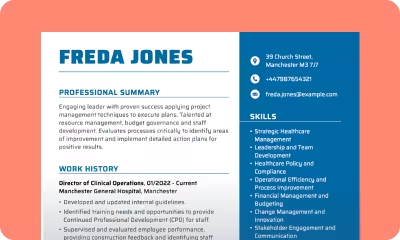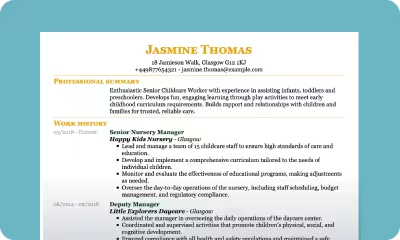- Our customers have been hired by : *Foot Note
If you are eager to get a new job as a drafter, it is necessary to create a CV that reflects your top skills and expertise, and also determines your core strengths. Utilise our CV templates as a guide to support you in formatting your own CV, and pay attention to the do’s and don’ts to ensure that you make the best impression on any potential employer.
Below, our handy guide shows you the best way to write a CV, covering aspects such as:
SEARCH ALL CV EXAMPLES
Sample drafter CV
Anthony O’Brien
88 Boroughbridge Road, Birmingham B2 8SP
07912345678
Anthony.O’Brien@example.co.uk
Professional summary
Hard-working Drafter knowledgeable in relevant codes, construction techniques and best practices. Offers excellent communication and relationship-building skills with meticulous attention to detail.
Work history
June 2019 – Current
Bright Engineering – Birmingham
Drafter
- Consulted with architects, customers and vendors regarding project details, including scope, schedules and milestone dates.
- Supervised drafting teams completing multiple simultaneous projects and met all task milestones and deadlines.
- Maintained project schedules by managing timelines and making proactive adjustments.
February 2015 – May 2019
TC Developments – Birmingham
Junior drafter
- Maintained project schedules by managing timelines and making proactive adjustments.
- Trained junior staff on codes, best practices and suppliers, enabling better self-sufficiency and task completion.
- Evaluated information provided by architects and system subcontractors.
Skills
- Construction techniques
- CAD software proficiency
- Critical thinking
- Deadline-oriented
- Customer service
- Architectural knowledge
Education
University of Birmingham Birmingham
Bachelor of Science Architectural Technology
What is the best format for your drafter CV?
Formatting is crucial for your CV – both in terms of the structure and how it looks. In terms of layout, the CV format preferred by recruiters is reverse-chronological. This means starting with contact details and a personal statement, showcasing your experience starting with your most recent employment, adding a concise skills list, then listing education – again starting with the most recent qualification.
A skills-based format may be appropriate for entry-level roles if you don’t have any experience. In this case, work history is swapped for a more detailed skills section. However, it’s rarely suitable for drafter roles, given that most educational courses will include some experience as a starting point.
As for the overall look, you should keep things professional with conventional fonts like Arial and Times New Roman. Stick to black for the main body of the CV, though you can use a pop of colour for headings, margins, or other design features. Finally, try to keep your CV on one or two pages.
Top tips for drafter CV writing
Write a cover letter
Writing a cover letter is a great way to add more detail about your background, skills, and achievements without making your CV too long. You can include real-work scenarios to highlight your competencies. For example, detailing how you delivered a project under budget or how you impressed a client while working on plans and drawings.
Abbreviate technical terms
As a drafter, you’ll know technical terminology, which should be included in your CV. But long phrases and wording will take up precious space on your CV, so use appropriate abbreviations. Employers looking for suitable candidates will understand common shortened words such as CAD (computer-aided design), so don’t be afraid to use it.
Use words from the drafter job description
Some recruiters use software to go through applications. They’ll be looking for key words and phrases from the job description. Making your CV relevant to the job advert will ensure it passes through these systems and makes it onto the employer’s desk.
Include your specialisms
The role of drafter is extremely technically minded so if you have expertise or specialisms in specific areas related to the job role, mention them. In addition, employers want to see people that stand out from the competition, so adding these additional details could put your application at the top of the pile.
Use positive language
It can be easy to write a CV purely to answer the job role requirements. But recruiters want to see some personality too. It’s trickier to do this with limited space, but it’s not impossible. Simply use positive adjectives in the personal statement and throughout the CV. This brings out your personality and shows your written communication skills perfectly.
How to write a CV for a drafter
You know better than anyone about your capabilities, qualifications, and experience. But how do you pass that information on to a recruiter? The key is clarity. Don’t try to overcomplicate things. Instead, stick to short sentences, bullet points, and simple word choices.
Of course, there’s a little more to it than that. In the guide below, we cover every area of how to write a CV for a drafter, including what your CV should include in each section and some handy tips on making the process simple:
- What contact details should I include in my drafter CV
- How to write a personal statement for your drafter CV
- How to present your work history on a drafter CV
- Great skills to add on your drafter CV
- Get education right on your drafter’s CV
What contact details should I include in my drafter CV
The first thing to add to your drafter CV are your contact details. This is a really simple section but including the correct details is essential. This is how recruiters get in contact with you about jobs, so follow these simple steps.
Include the following:
- Name – Use your first name and surname – skip the initials and nicknames
- Address – Add your full address and postcode
- Phone number – Include a mobile number or home phone or both
- Email address – Use a work-appropriate email
Example of contact section for a drafter
Alan White
7 Blueberry Lane
Edgeville, E1 2BC
07123456789
a.white@example.co.uk
How to write a personal statement for your drafter CV
The personal statement section is a short paragraph to introduce a recruiter to your background, skills, and capabilities. This gives a small insight into how you might fit into the role. But, it’s essential to consider a few things when writing it, such as:
The key to writing a personal statement is:
- Write in the third person – this details what you offer
- 3-4 sentences are ample
- Use positive words such as “creative”, “motivated”, and “organised.”
- Include technical skills and achievements if necessary
- Highlight expertise if relevant such as “knowledge of CAD software”.
Example of personal statement for a drafter CV
Hard-working drafter knowledgeable in relevant codes, construction techniques and best practices. Offers excellent communication and relationship-building skills with meticulous attention to detail. Skilled and detail-orientated person with keen creativity, adaptability and problem-solving skills.
OR
Enthusiastic drafting professional specialising in computer-aided design and able to generate accurate, detailed representations of buildings, systems and components. Follows tight schedules to complete projects on time and within contract requirements. Knowledgeable about established codes and regulations for different project types.
How to present your work history on a drafter CV
Your work history makes up a significant part of your CV, so it’s essential to get it right. Here you’ll include information about previous roles and ensure they are relevant to the position you’re applying for. This section should start with your current or most recent job first, including:
- Start and end date
- Job title, employer and location
- List 3-6 duties for each job
As this is the largest part of your CV, it contains a lot of information. But to avoid repeating details, try not to overlap tasks or duties from one job to another. For example, if you have CAD experience from one role, mention your mathematical skills in another.
Example of work experience for a drafter CV
Drafter, Bright Engineering, London | May 2019 to Present
- Trained junior staff on codes, best practices and suppliers, enabling better self-sufficiency and task completion.
- Consulted with architects, customers and vendors regarding project details, including scope, schedules and milestone dates.
- Developed new business by networking with valuable customers.
- Reviewed specifications to generate intricate details of individual system components.
Junior drafter, TC Developments, London | February 2014 to May 2019
- Evaluated information provided by architects and system subcontractors.
- Utilised computer-aided design software to prepare blueprints.
- Created accurate drawings according to measurements and specifications.
- Maintained project schedules by managing timelines and making proactive adjustments.
Great skills to add on your drafter CV
As a drafter, you will work on numerous projects and tasks throughout your career. To do the job successfully, you’ll need the right skills and personal qualities. In the CV skills section, you can include all skills related to the job, such as technical abilities, plus some soft, desirable skills to make you stand out.
Essential skills for a drafter
- CAD software skills
- Construction, engineering and design principles knowledge
- Health and safety knowledge
- Project management
- Strong mathematical ability
Desirable aptitudes to set you apart
- Problem-solving
- Time management
- Attention to detail
- Reliability
- Team player
Get education right on your drafter’s CV
Recruiters are looking for candidates with a solid education behind them, whether from an apprenticeship, degree, or on-the-job courses. Some employers prefer a degree but technical knowledge is the key to getting your foot in the door.
In this section, you need to showcase your qualifications like so:
- School, college, university or training provider
- Year of qualification
- Level of qualification, for example, A-Levels, BA (Hons)
- Subject or course title – you don’t need this for high school courses
Example education section for a drafter
Bsc Architectural Technology
University of Cumbria
2018
BTEC – Engineering
Lancaster College
2015
Your drafter CV questions answered
What does a drafter do?
Drafters or CAD technicians typically work on technical plans and drawings for a range of products and components. Individuals work with other professionals, such as architects and design engineers, from project inception to completion. Day-to-day tasks differ depending on the industry, but some everyday duties include:
- Using CAD software to complete accurate drawings and plans
- Liaising with other professionals and organisations
- Calculating costs and feasibility assessments
- Maintaining records
- Site visits
- Surveying
What skills are needed for a drafter?
This role requires candidates to have a number of skills. Strong technical abilities are essential, as well as an aptitude to learn different techniques and practices on the job. A drafter needs a keen eye for detail and must work effectively as part of a team. Having a solid knowledge of computer systems and software for drafting is important. Plus, excellent communication skills ensure you can talk to people at all levels.
What qualifications are needed to be a drafter?
Drafters can enter this career at all levels of qualification. Some employers prefer a degree, while others accept apprentices who want to work their way up to an experienced draughtsperson. If you opt for an entry-level role, drafters start as a junior drafter, and it takes around three years to move up positions.
Do I need work experience to work as a drafter?
Employers typically require individuals to have at least some knowledge and experience in CAD software and design principles. This is usually gained through education, but internships are a great way to work with larger firms to build up a portfolio of work. Some degree courses also offer a placement year where you can work in the industry and gain relevant experience alongside study.
Draft your own drafter CV
Making your own drafter CV couldn’t be easier with myPerfectCV. Our CV examples show you how it’s done, while our customisable CV templates can give you a head start with the right structure and design. If you need anything else, head to our online builder for pre-written content about drafter responsibilities, skills, and experience.
*The names and logos of the companies referred to above are all trademarks of their respective holders. Unless specifically stated otherwise, such references are not intended to imply any affiliation or association with myperfectCV.




